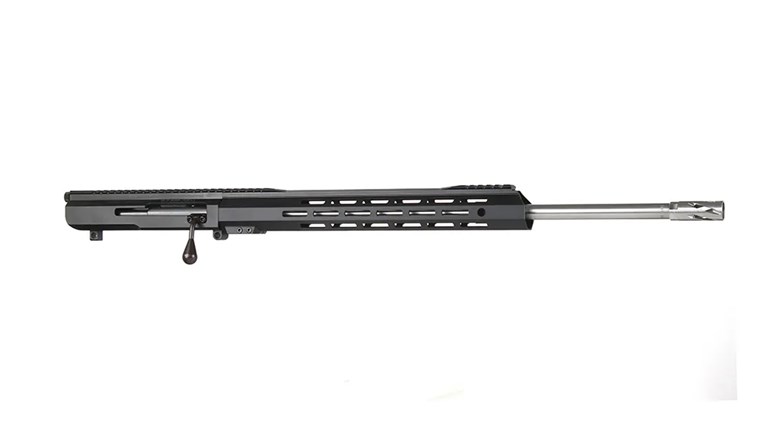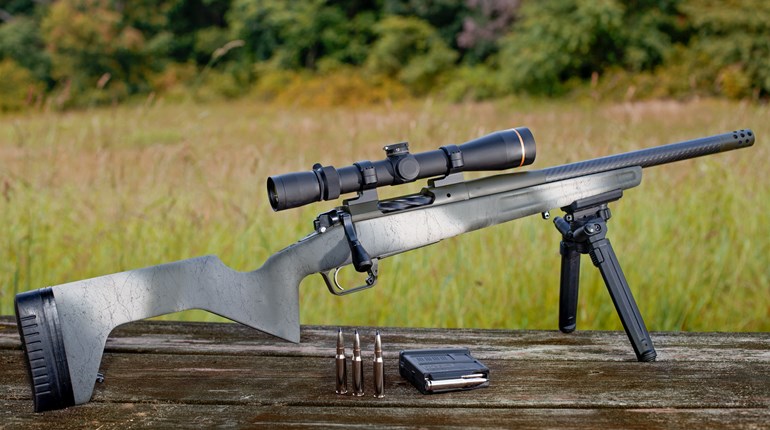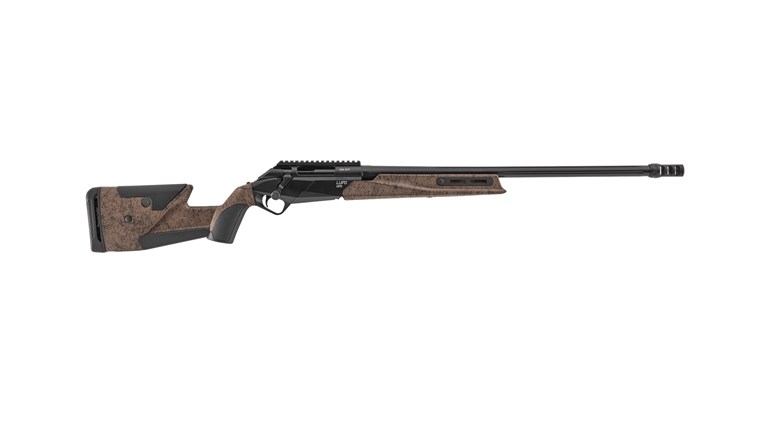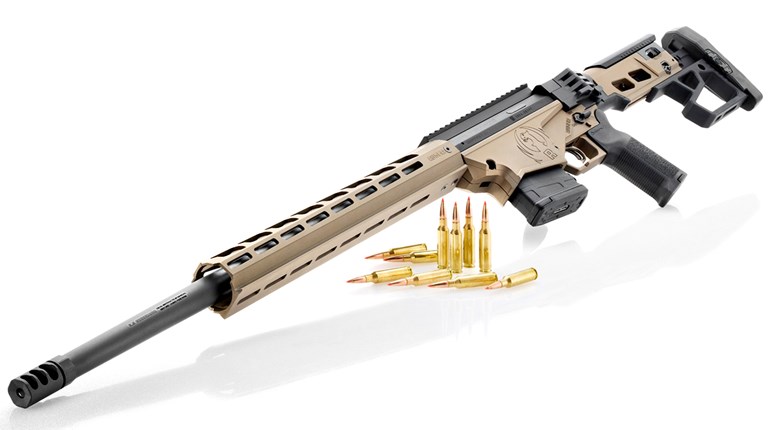
The hottest game in rifle shooting right now is long-range, and it would seem that chassis-built precision rifles are leading that trend. Once these rifles became affordable, sales took off and almost every major rifle maker has jumped into the market. With the resulting saturation, it becomes a struggle for market share. That means makers can start cutting price and begin the race to the bottom, or they can do something to make their rifle stand out from the crowd. Howa has certainly grabbed my attention with its latest offering.

The APC chassis is Cerakote-finished in the popular distressed American Flag motif. This work is done by Reno Cerakote and Hydrographics, and it results in an eye-catching rifle.
Japanese-built Howa rifles are in some ways the best-kept secret in the shooting world. It may not enjoy the name recognition of the big-name gun makers, but the company does have a reputation for reliability and excellent accuracy at a reasonable price.
Speaking of price, a precision chassis rifle with a custom Cerakote finish, complete with 4-16x50 mm scope installed on a 20-MOA canted rail, muzzle brake, bipod and a 10-round magazine would cost, what? Gotta be expensive, right? Everybody knows it’s pricey to set up a long-range rifle. This Howa, as described, has an MSRP of $1,599. I don’t know of any option out there that can take you from the box to the shooting range for less expense. This rifle is range-ready out of the box—just add ammo.

The long gun is offered in .223 Rem., 6.5 Creedmoor and .308 Win., with multiple barrel-length and contour options. The 24-inch barrel on my 6.5 Creedmoor test rifle is hammer-forged, and the barrel and action appear to be finished in black oxide. The heavy barrel measures .830 inch in diameter directly behind the Midwest Industries MB1 three-chamber muzzle brake. The barrel is threaded 5⁄8x24 tpi at the muzzle to allow using a different brake or attaching a sound suppressor. A thread protector is included if you wish to remove the brake.
One small complaint is that Howa does the cartridge-chambering identification on the side of the barrel, near the action as is common with a rifle fitted into most conventional stocks. The use of a tubular fore-end with the chassis covers this up and makes identifying the cartridge for which the rifle is chambered rather difficult to read.
The Howa Model 1500 action uses a two-lug bolt, which in this case is fitted with an M16-style extractor and a spring-loaded, plunger-type ejector. The bolt handle is “standard” size rather than the popular oversize handles seen on most precision rifles. I can’t comment as to whether this would be a detrimental design for hard-core PRS competition, but I had no issues manipulating the bolt during my shooting and testing of the rifle. If it’s a problem, Howa offers an aftermarket, clamp-on, oversize bolt knob.
A three-position safety is located on the right side of the rifle and locks the bolt shut in the rear, safe position. The center position is safe, but allows the bolt to be open for loading or unloading. Forward is fire. The two-stage trigger breaks at just more than 3 pounds, which is a bit stiff for a precision rifle. The first stage is only about 5 ounces, so the second stage is pretty close to the full pull weight. It breaks clean with no catches or glitches. The folks at Howa tell me that the trigger is gunsmith-adjustable down to 2 pounds.

The aluminum-alloy chassis is fitted with an octagonal, 16-inch fore-end/hand protector, slotted for M-Lok attachments for rails or accessories. Additionally, other decorative cuts aid in cooling. There is a small rail attached on the bottom in the forward position that has a sling swivel stud installed. This is for fitting the included bipod, which is adjustable from 6 to 9 inches of height. The LuthAR buttstock has pockets for quick-release sling swivels, but the gun lacks a forward attachment. That can be remedied with an M-Lok sling attachment.

Thankfully, Howa designed the bottom metal for a detachable-box magazine, a 10-round polymer version of which is included. As far as I can determine, the magazine is a proprietary design. I tried several other aftermarket magazines and none would fit into the rifle. My sample rifle had a conversion kit to change the rifle to a conventional drop-floorplate magazine. The detachable magazine is released by a small lever in the front of the magazine box. This lever could be a little larger, and I suspect a competitive shooter may want to replace it with something a bit easier to locate and faster to operate.
The grip is a rubber Hogue model with finger grooves and pebbled gripping surfaces on each side. The rear of the chassis system is fitted with a LuthAR MBA-4 Fully Adjustable Stock. Randy Luth is a good friend of mine, and I have been using his stocks since he started his company some years ago. I can tell you without reservation they are rugged and well-designed.

An Evolution Gun Works (EGW) 20-MOA Picatinny rail atop the receiver provides extra elevation for long-range shooting. The included mounting rings are of the heavy-duty, four-screw design and attach to the rail with a rather small Torx-head screw. The rifle comes with a Nikko Stirling Diamond LR 4-16x50 mm scope mounted. This 30 mm-tube scope has an aircraft-grade aluminum, one-piece main tube, and uses a second-focal-plane Holdfast glass-etched reticle. This reticle has multiple holdover points that can be matched to a specific trajectory. Lenses on this scope are fully multicoated, and its target-style turrets are adjustable in quarter-MOA increments. There is a zero-stop function on both turrets. Parallax adjustment is on the left side and is in conjunction with the reticle-illumination knob. There is a fast-focus ring on the ocular bell, and a 3-inch sunshade is included.
This package is a real attention getter at the range—everybody has to stop and look at it and comment on the rifle’s American-flag coating. The consensus is that it’s a great-looking rifle.
I tested the rifle 25 shots at a time before letting the barrel cool. A precision rifle must be able to shoot just as well hot as it can with a cold bore. It must also never shift point-of-impact as it heats up. This rifle did all that well. It maintained accuracy when hot; in fact, some of the best groups came from a hot barrel. It did not shift point-of-impact, no matter how hot the barrel became.

Accuracy was not the best I have seen from a factory precision rifle, but it was far from the worst. I would guess that it falls right on the average of the multiple mass-produced, precision rifles I have tested in recent years. The overall, average-group size for all 15, five-shot groups I fired at 100 yards was 1.04 inches. The gun showed a clear preference for some ammo brands, while not favoring some other factory ammo, so that average is a bit skewed. The Hornady 120-grain Match ammo shot best, averaging .81 inch, so it’s fair to say this rifle exceeds the Howa 1-MOA guarantee. I suspect a serious shooter who is handloading can easily shave a few tenths off the group size and that .75-MOA groups—or perhaps even better—are a reasonable expectation for this rifle. That is exceptional accuracy from a factory model.
The gun was cleaned before starting and I completed the test without any further bore cleaning. I did not break-in the barrel, although Howa recommends a break-in period. While this process has somehow become controversial, I fail to understand why. Every barrel I have taken the time to break-in has resulted in a good-shooting rifle. On the other hand, I only break-in good barrels, so it might be the dog wagging the tail or the tail wagging the dog. Either way, it never hurts a barrel. I read on the web about the anguish of the extra rounds causing the barrel to shoot out prematurely. Really? I’ll typically break-in with 20 rounds or fewer. Most 6.5 Creedmoors will last 2,500 rounds or more before needing a new barrel. I don’t think 20 rounds is going to wear out the gun prematurely. Most hammer-forged barrels (like the one on the American Flag Chassis Rifle) are pretty smooth to start with anyway and do not need the break-in attention that other types of rifling require.

Function of the rifle was pretty close to perfect. I had two failures to feed, but both were because I failed to seat a fully loaded magazine. That’s on me, not the rifle. The bolt runs smoothly and recoil is well-mitigated by the muzzle brake and the weight of the rifle.
The scope is optically clear, even turned up to full magnification. The adjustments moved the point-of-impact the distance expected, and the turrets lock in place so they won’t be moved while putting the gun in or out of a case.
As an aside, I am friends with a very well-known shooter. He tells a funny story about pulling his wife’s rifle out of a case while getting ready for a match. He heard a zzzzzzziiiiipppppp as the turret turned while rubbing on the case. He just listened as he quickly turned it back, trying to match the sound, and brought the rifle to the line. She shot well in the match, so he never mentioned anything about what happened. The moral of the story is locking turrets generally prove cheaper than divorce lawyers.
To adjust the reticle, you must pull up (or out for the windage turret), make the adjustments and then push it back into the scope to lock them in place. The turrets have locking rings on top that unscrew with a coin so the turret rings can be set to zero after the sighting-in process.
I really like this rifle and am amazed by the value the package brings to long-range shooting. Anybody looking to get into the sport would do well to consider the Howa American Flag Chassis Rifle. It’s a complete package, assembled and ready to go at a remarkably reasonable price. On top of that, it’s about the best-looking long-range rifle I have seen.





































